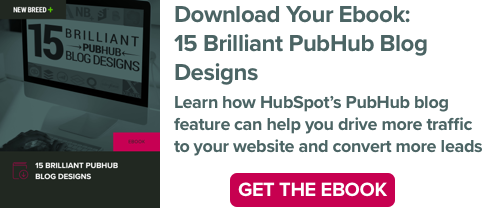 It is the age of content marketing, and blogging has quickly become the leading tactic that companies are leveraging to increase traffic to their websites and generate leads. But still, we see resistance. As with anything, there are always non-believers, but we want to use today's post to share the many benefits of blogging for B2B companies.
It is the age of content marketing, and blogging has quickly become the leading tactic that companies are leveraging to increase traffic to their websites and generate leads. But still, we see resistance. As with anything, there are always non-believers, but we want to use today's post to share the many benefits of blogging for B2B companies.
But, before we do, we want to share a little case study. A case study on ourselves. We're firm believers that if we don't try what we preach on ourselves, than we have no business selling it to our customers. So each technique that we talk about, we always test on ourselves first.
Business blogging is precisely one of these tactics. When we first began building out our content strategy, we focused on three things: blogging, email marketing and social media. After a year+ of writing and producing content on a consistent basis, we can tell you out of the three content areas we focused on, blogging has produced the best results for us by far.
- We've seen over 2x the amount of traffic
- We've seen an 5x increase in leads
- Our conversion rates have steadily increased each month
- And we're ranking higher in search engines
We are proof that blogging, while time consuming we know, is a marketing tactic that truly does produce results. So, today we're going to talk in more detail about 5 benefits of blogging for your B2B company.
1) Attract Qualified Traffic to Your Website
First and foremost, blogging is an attraction strategy. And when we say "attraction" we're not talking about trying to get a date with a pretty girl or studly guy. We're talking about attracting the right people to your website (aka your ideal customers). When you look at our inbound marketing process graphic, you will notice that blogging is in the beginning stages of the process, meaning it's meant to help you attract more qualified visitors to your website.
How does that work you might be wondering? We'll talk about ranking in more detail in a later point, but essentially, by having a blog (that you are updating consistently), you're producing more content, your site is getting crawled by search engines more frequently and your content is getting shared on social media more frequently. And since you've targeted and optimized your content for your particular buyer personas, you will be bringing those people to your website
2) Convert more Leads
We have found that our blog is not only a great tool for attraction, but it also has helped us increase our conversion rates. With every blog post we produce (which is on a daily basis now), we make sure we include a relevant CTA at the bottom. What does this do?
After the reader has finished the article, you're giving them a next action to take. If they enjoyed your article, and your content offer aligns with what you were talking about (ex: a blog post about business blogging and then the Ultimate Guide to Business Blogging), they'll like opt-in to receive that content. And bam! You've just converted a visitor into a lead.
3) Close more Customers
Traditionally, it's up the sales team to close your customers. They're the ones with the relationships, and they're the sweet talkers who know how to sell your product. And we're not trying to say they're not effective, because they are an essential piece to the puzzle, but what we are saying is that your blog can be an asset for them during the sales process as well.
Not only can you direct opportunities to your blog during the sales cycle, pointing them to posts that are relevant to their needs and that answer some of their questions, but it also helps to position you as a knowledgeable source that they can trust. If your content is good, use that to your advantage.
Another way that has helped us close more customers from our blog is by adding a "Subscribe to our Blog" option after every post as well as in every form. If people don't choose to convert on a CTA, but subscribe to your blog, they've still expressed interest and should be marketed and sold to. Don't waste those opportunities and precious page views by not offering your readers a place to opt-in. People who buy into your content are much more likely to purchase from you down the road.
4) Rank Higher in Search Engines
Each and every one of you blog posts should be optimized for search. If not, what is the point? The whole goal is for that page to be found by people, and you're going to have a much harder time of that if you're not coming up in search results.
Did you know, every month Google processes 100 billion search queries? And 15% of the search queries made on a daily basis have never been searched for before? Crazy stuff, right?
And that's just Google that we're talking about, that doesn't consider the other search engines that people use.
So...let's think together for a minute. If there are 100 billion search queries made every single month, that means there are on average, each person in the world searches for something on Google 14.5 times per month. Now, not everyone in the world is searching for things on the internet, so say it's more like 20 -25 searches per month. That's one almost every single day.
How many times have you used Google (or another search engine) to find information today? I've done at least 7 or 8 and it's only 8am.
This brings us back to the main point of this section. If you're not optimizing your blog posts for search engines, you're doing yourself and your business a huge disservice. As you develop your buyer personas, you should also be thinking about generating a list of keywords that this persona would use in search.
Now, when you're developing your editorial calendar, use that list of keywords as a reference point and map your posts back to those words. Then optimize all parts of the post as you're writing it.
The result? You'll start to rank higher for the words that are relevant to your target audience, thus attracting them to your website and hopefully converting them into leads.
5) Establish Thought Leadership
Blogs are a great place to establish thought leadership. Although business blogs differ slightly from personal blogs, the gist behind them is still the same. They're a place where you share information and where people can come to and learn.
Since your blog is unique to your company and business, use this space to produce content that is innovative, exciting, and that will help position your company as a thought leader in your industry. Whether you're a tech company talking more about your driver-less car technology or a software company that has is creating a product that will change your industry forever, talk about that. Talk about your discoveries, your ideas, your innovations. Talk about what makes you unique and what is special about your company.
Once you have established yourself as a thought leader, many great things start to happen. First, you become a trusted source for information. Second, you become the go-to source for that type of information. And third, large companies and media sites will start to take notice and link to your content, helping you increase your search rankings even more.
Image Source: Cyber Defense Magazine





